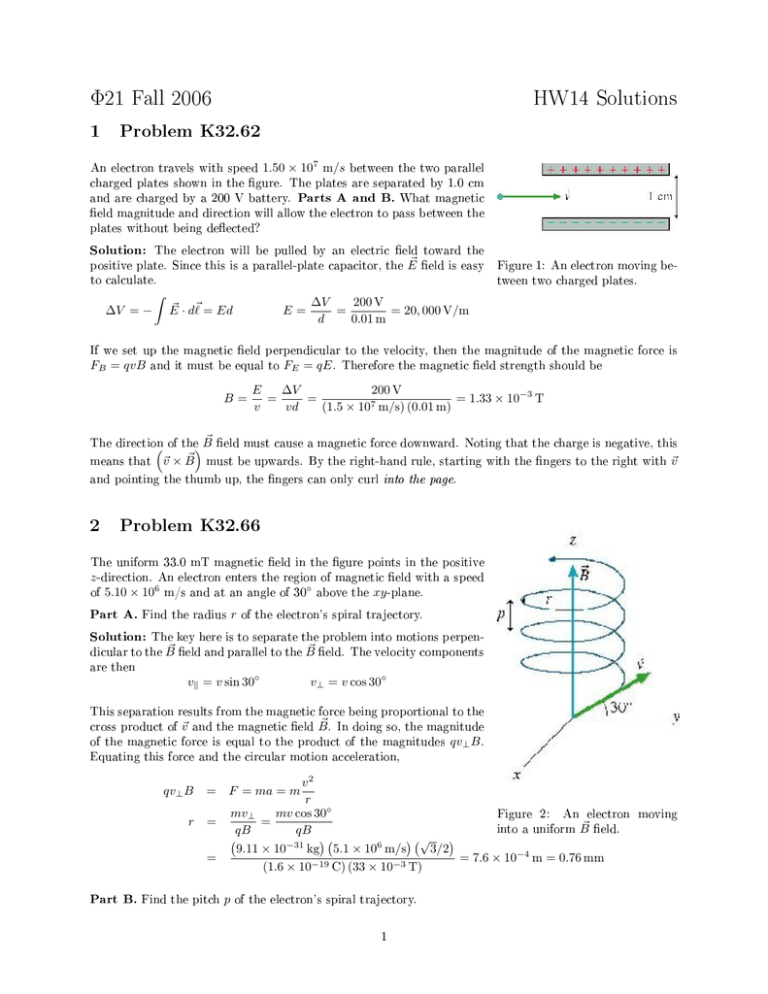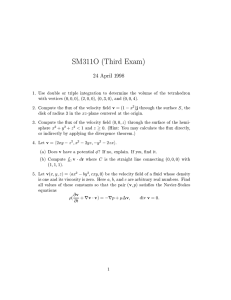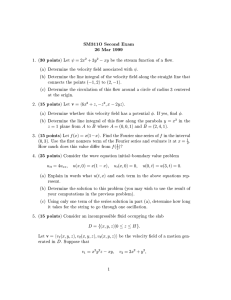Φ21 Fall 2006 HW14 Solutions
advertisement

Φ21 Fall 2006 1 HW14 Solutions Problem K32.62 An electron travels with speed 1.50 × 107 m/s between the two parallel charged plates shown in the gure. The plates are separated by 1.0 cm and are charged by a 200 V battery. Parts A and B. What magnetic eld magnitude and direction will allow the electron to pass between the plates without being deected? The electron will be pulled by an electric eld toward the ~ eld is easy Figure 1: An electron moving bepositive plate. Since this is a parallel-plate capacitor, the E to calculate. tween two charged plates. Solution: ∫ ∆V = − ~ · d~` = Ed E E= ∆V 200 V = = 20, 000 V/m d 0.01 m If we set up the magnetic eld perpendicular to the velocity, then the magnitude of the magnetic force is FB = qvB and it must be equal to FE = qE . Therefore the magnetic eld strength should be B= ∆V 200 V E = = = 1.33 × 10−3 T v vd (1.5 × 107 m/s) (0.01 m) ~ The direction ( of the)B eld must cause a magnetic force downward. Noting that the charge is negative, this ~ must be upwards. By the right-hand rule, starting with the ngers to the right with ~v means that ~v × B and pointing the thumb up, the ngers can only curl into the page. 2 Problem K32.66 The uniform 33.0 mT magnetic eld in the gure points in the positive z -direction. An electron enters the region of magnetic eld with a speed of 5.10 × 106 m/s and at an angle of 30◦ above the xy -plane. Part A. Find the radius r of the electron's spiral trajectory. The key here is to separate the problem into motions perpen~ eld and parallel to the B ~ eld. The velocity components dicular to the B are then Solution: vk = v sin 30◦ v⊥ = v cos 30◦ This separation results from the magnetic force being proportional to the ~ . In doing so, the magnitude cross product of ~v and the magnetic eld B of the magnetic force is equal to the product of the magnitudes qv⊥ B . Equating this force and the circular motion acceleration, qv⊥ B r = = Part B. v2 r mv⊥ mv cos 30◦ Figure 2: An electron moving = ~ eld. into a uniform B qB qB ) ( ) ( ) (√ 3/2 9.11 × 10−31 kg 5.1 × 106 m/s = 7.6 × 10−4 m = 0.76 mm −19 −3 (1.6 × 10 C) (33 × 10 T) = F = ma = m Find the pitch p of the electron's spiral trajectory. 1 ~ eld is found from vk and the time it takes the The distance the electron moves parallel to the B electron to make one circular motion in the xy directions. Solution: ( p = vk ∆t = vk 3 2πr v⊥ ) = tan 30◦ 2π (0.76 mm) = 2.76 mm Problem K32.71 The two springs in the gure each have a spring constant of 12.0 N/m . They are stretched by 1.30 cm when a current passes through the wire. How big is the current? Solution: (The springs ) exert a total force of FS = 2kx = 2 (12.0 N/m) 1.3 × 10−2 m = 0.312 N. Since the current is perpendicular to the magnetic eld, its magnitude is just F = ILB . Solving for I: F 0.312 N I= = = 3.12 A LB (0.2 m) (0.5 T) 4 Problem K32.72 Figure 3: The magnetic force on a current is balanced by a pair of springs. The gure is a cross section through three long wires with linear mass density 49.0 g/m. They each carry equal currents in the directions shown. The lower two wires are 4.0 cm apart and are attached to a table. What current I will allow the upper wire to "oat" so as to form an equilateral triangle with the lower wires? ~ Both of the lower wires will contribute to a magnetic eld B that will be felt by the upper wire. Since the two contributions are vectors, they must be added in component form. Each eld will be clockwise around its wire, according to the Right-Hand Rule. The eld of the left Figure 4: An arrangement of current, measured at the location of the top current, will be: three current-carrying wires each ) ( with a current I . µ I µ I 0 0 ◦ ◦ ~ Solution: BL = 2πR B̂L = 2π (0.04 m) cos 30 î − sin 30 ĵ The eld of the right current at the same location will have the same î component while the ĵ components will cancel. The total eld is: ~ tot = B µ0 I (2 cos 30◦ ) î = 8.66 × 10−6 I î 2π (0.04 m) The force on the top wire will then be in the up direction, with the magnitude F = ILB = 8.66 × 106 LI 2 ( ) ( ) This force must be exactly the same as the force of gravity, F = mg = 49.0 × 10−3 g/m L 9.8 m/s2 = 0.48 L. Equating the two forces cancels out the made-up length L and gives I : I2 = 0.48 8.66 × 10−6 I = 235 A 2





